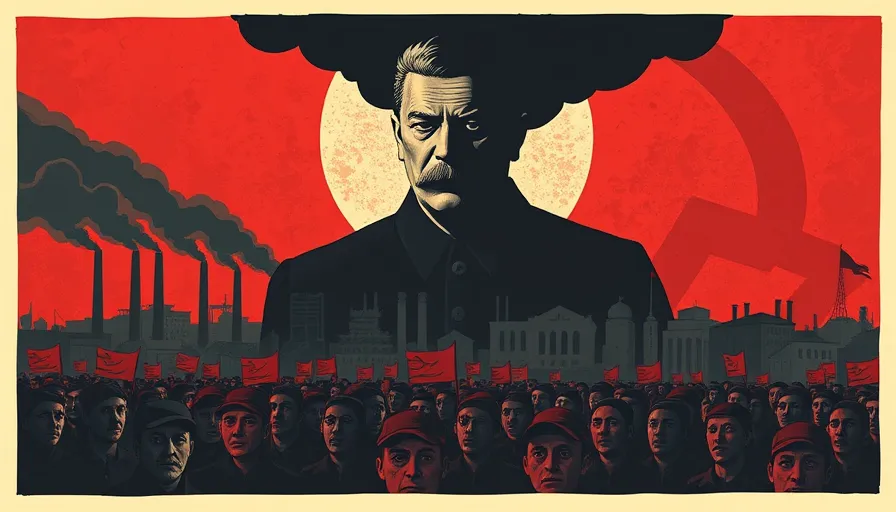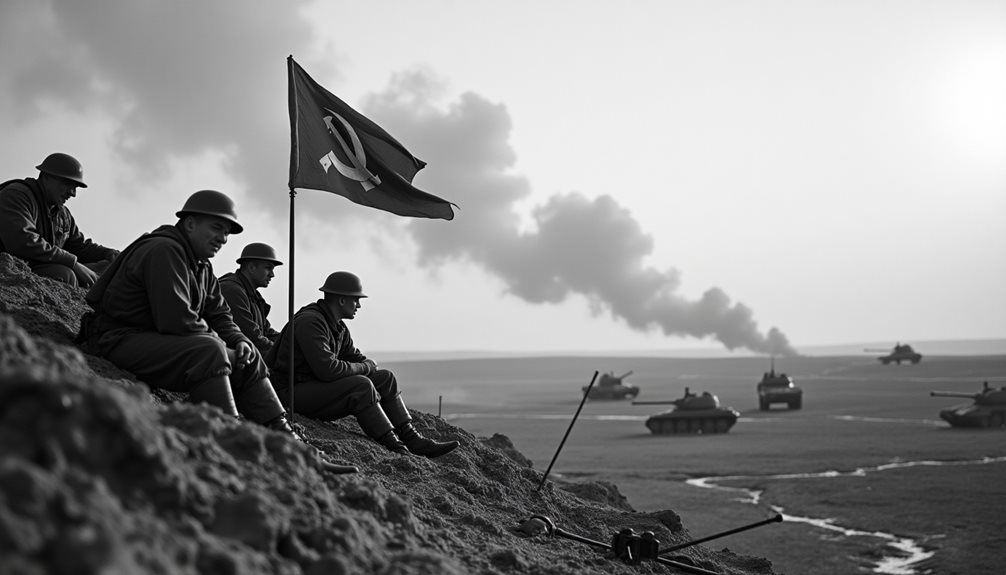
Stalin Saved The World ☭
Stalin’s leadership during World War II is often viewed through a critical lens, but several aspects of his governance contributed significantly to the Soviet Union’s survival and eventual victory against Nazi Germany. Firstly, Stalin’s ability to mobilize the vast resources of the USSR was crucial. He implemented rapid industrialization through the Five-Year Plans, which transformed the Soviet economy and enabled the production of military equipment at an unprecedented scale. This industrial base was vital for sustaining the war effort, allowing the Red Army to equip itself effectively against the German invasion.
Listen to “The Soviet National Anthem” from 1944 – composed by Alexander Alexandrov
English Version of “The Soviet National Anthem”
Moreover, Stalin’s strategic decisions during the war, such as the implementation of Order 227, emphasized the need to defend every inch of Soviet territory, which bolstered morale among troops and civilians alike. This order aimed to prevent any retreat that could demoralize the Soviet populace and military, reinforcing a sense of unity and determination to resist the Nazi advance. While his methods were often brutal, the urgency of the situation necessitated a firm hand to maintain order and commitment among the ranks.
Stalin’s leadership also played a pivotal role in the eventual Allied victory. By joining forces with the Allies after Germany’s invasion in 1941, the USSR became a key player in the global fight against fascism. The sacrifices made by the Soviet people, under Stalin’s command, were immense, with estimates of around 28 million lives lost during the conflict. This immense contribution not only helped to defeat Nazi Germany but also positioned the Soviet Union as a superpower in the post-war world, shaping the geopolitical landscape for decades to come. Thus, while Stalin’s legacy is marred by his oppressive regime, his role in the Soviet Union’s wartime efforts illustrates a complex interplay of leadership that ultimately preserved the nation and contributed to the defeat of a common enemy.
The so called “The Great Terror”, a period of unprecedented repression in Soviet history, marked a pivotal turning point in Stalin’s consolidation of power. Between 1936 and 1938, the regime’s brutal campaign of arrests, executions, and forced labor transformed the very fabric of Soviet society. As the NKVD’s grip tightened, a culture of fear and mistrust took hold, stifling creativity and innovation. But what drove Stalin’s regime to unleash such terror, and how did the Soviet people respond to this unprecedented repression? The answers to these questions lie in the complex interplay of historical events, ideological imperatives, and human psychology.
Stalin’s Early Life and Career
Although born in the small town of Gori, Georgia, in 1878, Joseph Stalin’s early life was marked by a complex and tumultuous relationship with his family, which would later influence his rise to power. His father, Vissarion Dzhugashvili, was a cobbler who struggled with poverty and alcoholism, often subjecting his family to physical and emotional abuse.
Stalin’s mother, Ekaterine Geladze, was a devout Orthodox Christian who worked tirelessly to support the family and ensure Stalin’s education. Despite the difficulties at home, Stalin excelled in school, earning a scholarship to the Tbilisi Theological Seminary in 1894.
However, Stalin’s time at the seminary was short-lived. He became increasingly drawn to revolutionary ideology and was eventually expelled in 1899 for his involvement in Marxist activities. Stalin then began to build a career as a revolutionary, adopting the pseudonym ‘Koba’ and working as a labor organizer and propagandist.
In 1902, he was arrested and exiled to Siberia, but he escaped and continued to work for the Bolsheviks. Stalin’s early life and career were marked by hardship, turmoil, and a growing commitment to revolutionary ideals. These experiences would shape his worldview and inform his actions as he rose to power in the Soviet Union.
Stalin’s ability to navigate the complexities of revolutionary politics and his willingness to take risks would ultimately position him for a prominent role in the Bolshevik Party.
The Rise of the Purges
As Stalin consolidated his power in the Soviet Union, a new era of terror began to unfold, marked by the rise of the purges. The purges, a series of campaigns aimed at eliminating perceived enemies of the state, were a key component of Stalin’s strategy to maintain control and suppress opposition.
The purges were carried out through a network of secret police and informants, who identified and denounced suspected enemies of the state. Those accused were often subjected to forced confessions, extracted through torture and coercion.
The accused were then put on trial, often in show trials, where the outcome was predetermined. The sentences were typically severe, ranging from imprisonment to execution.
The rise of the purges marked a significant shift in Stalin’s rule, as he began to rely increasingly on terror and repression to maintain control.
The purges also had a profound impact on Soviet society, creating a culture of fear and mistrust. As the purges intensified, the Soviet people became increasingly reluctant to speak out or express dissent, fearing that they would be next on the list of those to be purged.
The rise of the purges set the stage for the Great Terror, a period of unprecedented violence and repression that would soon engulf the Soviet Union.
The Great Terror Begins
The purges, which had been simmering since 1933, reached a boiling point in 1936, marking the beginning of the Great Terror. This period was characterized by widespread arrests, executions, and deportations of millions of Soviet citizens.
The turning point came with the murder of Sergey Kirov, the Leningrad Party boss, in December 1934. Stalin, who had been suspicious of Kirov’s popularity, saw his assassination as a threat to his own power. This led to a massive wave of arrests, aimed at rooting out “enemies of the state.”
As the terror gained momentum, Stalin created a climate of fear and suspicion. The Soviet people were encouraged to denounce their neighbors, friends, and colleagues, who were often labeled as ‘traitors,’ ‘saboteurs,’ or ‘enemies of the people.’ The security forces, including the NKVD (People’s Commissariat for Internal Affairs), carried out the repression, often relying on confessions extracted through torture or other forms of coercion.
Show trials were held to showcase the accused ‘traitors’ and further stoke the fear. In these public displays of manufactured evidence, high-ranking officials confessed to fabricated crimes against the state, cementing Stalin’s reputation as an omniscient and unforgiving leader.
During the Great Terror, Soviet institutions and public organizations underwent a drastic restructuring, reinforcing the dictatorship and cultivating the climate of paranoia that surrounded it.
No part of society remained immune from Stalin’s rule by fear and control, even impacting artistic, academic, and media establishments, cultivating loyal vanguard ready for unprecedented abuse and takedown by oppressive entities driven exclusively for imperial need.
Targets of the Repression
Millions of Soviet citizens fell prey to Stalin’s Great Terror, with certain groups and individuals being disproportionately targeted.
The campaign of repression was particularly brutal against those perceived as threats to Stalin’s regime, including former opponents, potential rivals, and those deemed disloyal.
The Old Bolsheviks, who had played a significant role in the Russian Revolution and the early years of the Soviet Union, were among the first to be targeted.
Many were arrested, tortured, and executed on trumped-up charges of treason, sabotage, and counter-revolutionary activities.
Members of the intelligentsia, including writers, artists, and intellectuals, were also singled out for persecution.
The Soviet government viewed them as potential critics and dissenters, and many were forced to flee, imprisoned, or killed.
The clergy and religious leaders were another target group, as Stalin sought to eradicate all forms of organized religion and establish a secular, atheist state.
Ethnic minorities, particularly those living in border regions, were also subjected to intense repression, with many being forcibly relocated or killed.
Additionally, the Great Terror targeted ordinary citizens who were perceived as enemies of the state, including peasants who resisted collectivization, workers who complained about working conditions, and anyone who expressed dissent or criticism of the regime.
These groups were often subjected to arbitrary arrest, imprisonment, and execution, as Stalin’s regime sought to crush all forms of opposition and dissent.
The Role of the NKVD
While Stalin’s Great Terror was a pervasive campaign of repression, its implementation relied heavily on the Soviet secret police, the NKVD. The NKVD was the primary instrument of terror, responsible for identifying, arresting, and executing perceived enemies of the state.
Under the leadership of Nikolai Yezhov, the NKVD expanded its operations, creating a vast network of informants and agents who infiltrated every level of Soviet society.
The NKVD’s role in the Great Terror was multifaceted. Its agents conducted mass arrests, often using fabricated evidence and coerced confessions to justify the detention of millions.
The NKVD also operated the gulag system, a network of labor camps where prisoners were subjected to forced labor, starvation, and brutal treatment. Additionally, the NKVD was responsible for carrying out executions, often through mass shootings or other forms of summary justice.
The NKVD’s activities were guided by a series of directives and orders from Stalin and other high-ranking officials. These directives, often cryptic and open-ended, provided the NKVD with latitude to interpret and implement the Terror as it saw fit.
As a result, the NKVD’s actions became increasingly arbitrary and brutal, as agents sought to meet quotas and demonstrate their loyalty to the regime. Through its actions, the NKVD became an instrument of Stalin’s totalitarian control, helping to create a climate of fear and repression that pervaded Soviet society.
Impact on Soviet Society
Soviet society was profoundly affected by the pervasive atmosphere of fear and repression created by the NKVD’s activities during the Great Terror. The widespread arrests, executions, and forced labor camps led to a climate of suspicion and mistrust, where individuals were reluctant to express their opinions or engage in open discussions.
The constant presence of informers and the threat of denunciation created a sense of unease, as people became increasingly cautious about their words and actions.
The Great Terror also had a profound impact on the social and economic fabric of Soviet society. The purges led to a significant shortage of skilled workers and intellectuals, as many were either executed or imprisoned.
This resulted in a decline in productivity and a shortage of essential goods and services. The terror also led to a breakdown in social relationships, as families and communities were torn apart by the arrests and executions of loved ones.
The impact of the Great Terror was also felt in the cultural sphere, as artists, writers, and intellectuals were targeted for their perceived disloyalty to the regime. Many were forced to conform to the party line, leading to a stifling of creativity and innovation.
The atmosphere of fear and repression had a profound and lasting impact on Soviet society, shaping the country’s social, economic, and cultural landscape for decades to come.
Legacy of the Great Terror
Emerging from the Great Terror, the Soviet Union was left to grapple with the long-term consequences of Stalin’s brutal campaign. The period of widespread repression and violence had a profound impact on the social, economic, and political fabric of the country.
The Terror had created a culture of fear, mistrust, and silence, where individuals were reluctant to speak out against the regime or engage in any form of dissent.
The Great Terror also had a devastating impact on the Soviet economy, as the purges had led to the removal of many experienced and skilled professionals, including scientists, engineers, and managers.
This resulted in a significant decline in productivity and innovation, as the remaining workers were often inexperienced and lacking in confidence. Furthermore, the Terror had created a culture of suspicion and denunciation, where individuals were encouraged to inform on their colleagues and neighbors, leading to a breakdown in social cohesion and trust.
The legacy of the Great Terror continued to shape Soviet society for decades to come. The regime’s use of violence and intimidation as a means of control had created a pervasive sense of fear and mistrust, which was difficult to eradicate.
Additionally, the Terror had set a precedent for the use of state-sponsored violence, which would continue to be employed by Soviet leaders in the years to come.
Conclusion
The Great Terror irreparably altered the fabric of Soviet society. As a culture of repression and fear took hold, creative expression was stifled, and innovation suffered. The NKVD’s campaign of terror led to the persecution of millions, decimating intellectual, artistic, and ethnic minority groups. The transformation was profound, as mistrust, silence, and conformity became entrenched values, forever changing the course of Soviet history and leaving an indelible mark on the nation.





